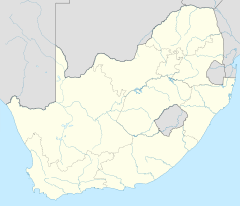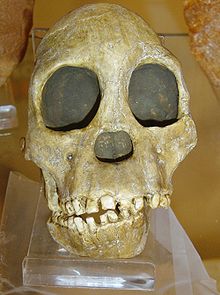- Cradle of Humankind
-
Coordinates: 25°58′02″S 27°39′45″E / 25.96716°S 27.66245°E
Fossil Hominid Sites of Sterkfontein, Swartkrans, Kromdraai, and Environs * UNESCO World Heritage SiteCountry South Africa Type Cultural Criteria iii, vi Reference 915 Region ** Africa Inscription history Inscription 1999 (23rd Session) Extensions 2005 * Name as inscribed on World Heritage List
** Region as classified by UNESCOThe Cradle of Humankind is a World Heritage Site first named by UNESCO in 1999, about 50 kilometres northwest of Johannesburg, South Africa in the Gauteng province. This site currently occupies 47,000 hectares (180 sq mi)[1]; it contains a complex of limestone caves, including the Sterkfontein Caves, where the 2.3-million year-old fossil Australopithecus africanus (nicknamed "Mrs. Ples") was found in 1947 by Dr. Robert Broom and John T. Robinson. The find helped corroborate the 1924 discovery of the juvenile Australopithecus africanus skull, "Taung Child", by Raymond Dart, at Taung in the North West Province of South Africa, where excavations still continue.
The name Cradle of Humankind reflects the fact that the site has produced a large number, as well as some of the oldest, hominid fossils ever found, some dating back as far as 3.5 million years ago.[2] Sterkfontein alone has produced more than a third of early hominid fossils ever found.[3]
Contents
History of discoveries
In 1935 Robert Broom found the first ape-man fossils at Sterkfontein and began work at this site. In 1938 a young schoolboy, Gert Terrblanche, brought Raymond Dart fragments of a skull from nearby Kromdraai which later were identified as Paranthropus robustus. Also in 1938 a single ape-man tooth was found at the Cooper's site between Kromdraai and Sterkfontein. In 1948 the Camp-Peabody Expedition from the United States worked at Bolts Farm and Gladysvale looking for fossil hominids but failed to find any. Later in 1948 Robert Broom identified the first hominid remains from Swartkrans cave. In 1954 C.K. Brain began working at sites in the Cradle including Coopers and he soon would initiate his three decade work at Swartkrans cave which would result in the recovery of the second largest sample of hominid remains from the Cradle. The oldest controlled use of fire was also discovered at Swartkrans and dated to over 1 million years ago.
In 1966 Phillip Tobias began his excavations of Sterkfontein which are still continuing and are the longest continuously running fossil excavations in the world. In 1991 Lee Berger of the University of the Witwatersrand discovered the first hominid specimens from the Gladysvale site making this the first new early hominid site to be discovered in South Africa in 48 years. In 1994 Andre Keyser discovered fossil hominids at the site of Drimolen. In 1997 Kevin Kuykendall and Colin Menter of the University of the Witwatersrand found two fossil hominid teeth at the site of Gondolin. Also in 1997, the near-complete Australopithecus skeleton of "Little Foot", dating to around 3.3 million years ago (although more recent dates suggest it is closer to 2.5 million years ago), was discovered by Ron Clarke. In 2001 Steve Churchill of Duke University and Lee Berger found early modern human remains at Plovers Lake. Also in 2001 the first hominid fossils and stone tools were discovered in-situ at Coopers. In 2010, Lee Berger discovered the partial remains of two hominids (Australopithecus sediba) in the Malapa Fossil Site that lived between 1.78 and 1.95 million years ago.
Sites
There are more than three dozen fossil-bearing caves in the Cradle of Humankind. Important sites include:
- Bolt's Farm
- Cooper's Cave
- Drimolen
- Gladysvale
- Gondolin
- Haasgat
- Kromdraai
- Malapa Fossil Site
- Minaars Cave
- Motsetsi
- Plovers Lake
- Sterkfontein
- Swartkrans
- Wonder Cave
Geological context
The hominin remains at the Cradle of Humankind are found in dolomitic caves and are encased in a mixture of limestone and other sediments called breccia and fossilised over time. Hominids may have lived all over Africa, but their remains are found only at sites where conditions allowed for the formation and preservation of fossils.
Visitor centres
On 7 December 2005, then South African President Thabo Mbeki opened the new Maropeng Visitors Centre at the site.[4]
See also
References
- ^ http://www.maropeng.co.za/index.php/about/
- ^ Fleminger, David (2008). The Cradle of Humankind. 30° South Publishers. pp. 7–10. ISBN 0958489130.
- ^ Smith, David (15 January 2010). "Visit to the Cradle of Humankind". London: The Guardian. http://www.guardian.co.uk/world/2010/jan/15/sterkfontein-caves-south-africa. Retrieved 2010-05-20.
- ^ "Mbeki opens Maropeng centre". News24. 8 December 2005. http://www.news24.com/News24/Technology/News/0,,2-13-1443_1847397,00.html. "Maropeng, which means 'the place where we come from,' is expected to receive over 500 000 visitors annually, according to the Gauteng provincial government."
- L.R. Berger and B. Hilton-Barber, Field Guide to the Cradle of Humankind (Struik, 2003)
External links
- Sterkfontein and Maropeng visitor attractions website
- Maropeng - The Cradle of Humankind Official Website
- UNESCO - Fossil Hominid Sites of Sterkfontein, Swartkrans, Kromdraai, and Environs
- Cradle of Humankind Map
- Palaeo Tours - Scientist-led tours to the "Cradle"
World Heritage Sites in South Africa For official site names, see each article or the List of World Heritage Sites in South Africa.Cape Floral Region Protected Areas · Fossil Hominid Sites of Sterkfontein, Swartkrans, Kromdraai and Environs · iSimangaliso Wetland Park · Mapungubwe Cultural Landscape · Richtersveld Cultural and Botanical Landscape · Robben Island · uKhahlamba / Drakensberg Park · Vredefort Dome
 Categories:
Categories:- World Heritage Sites in South Africa
- Gauteng
- Anthropology
- Prehistoric Africa
- Visitor attractions in Johannesburg
Wikimedia Foundation. 2010.



